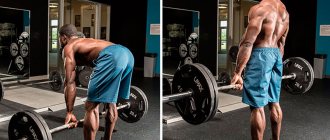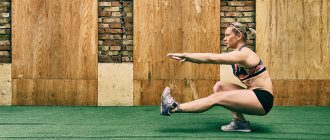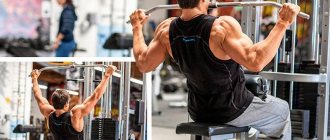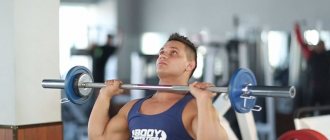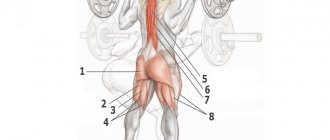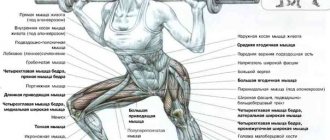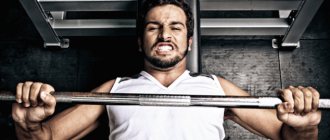Have you ever done a handstand? No?! Then go ahead and do this exercise, because it improves your mood, strengthens your muscles and is simply good for your health.
The handstand is a very underrated exercise, and one of the reasons for this is that most people think they can't do it. But just because you've never done gymnastics or yoga doesn't mean you can't do a handstand.
Handstands not only help you release your inner child and have fun, but they are also good for your health, especially if you do this exercise every day.
It doesn't matter whether you do a walk-up stand against a wall or in the middle of a room, there are 5 reasons why you should do it :
- Handstands make your upper body stronger
In order to stand on your hands for a certain amount of time, you will need strong shoulders, arms and back. It is not surprising that beginners, having stood on their hands, begin to tremble within the first seconds.
To get stronger, start doing handstands against a wall in three sets of 5-10 seconds. Gradually increase this time to a minute or two per set. Do this exercise as often as possible and you will soon notice that you are becoming much stronger.
- Handstands help develop balance
If you've ever tried to do a handstand, you know that not only do you need to be strong, but you also need to be able to balance yourself so you don't fall. This is especially important if you are doing a handstand without external support. This exercise requires muscle control, as you will need to change your body position to avoid falling.
- Handstands can improve your mood
Handstands will not only make you stronger and improve your sense of balance, but will also make you feel happy as the blood flow to the brain relieves fatigue and has a calming effect, especially when you are under extreme stress.
In addition, handstands, while improving your mood, help reduce the production of the stress hormone cortisol. This exercise not only reduces your stress levels, but may also relieve you of depression and anxiety.
- Handstands strengthen your abs
You no longer need to spend hours doing exercises to strengthen your abdominal muscles, because you can simply do handstands, which also help strengthen your abs.
When you stand on your hands and try to maintain your balance, you engage various muscles, which means you strengthen your abs.
- Handstand strengthens bones, promotes proper blood circulation and breathing
Although handstands are a weight-lifting exercise, they also help strengthen bones and reduce the chances of osteoporosis. This exercise is especially useful for the spine, shoulder bones, arms and wrists.
Handstands also help increase circulation to your upper body, while taking pressure off your feet and legs and stretching your diaphragm, which in turn increases blood flow to your lungs.
So do a handstand every day and you will not only improve your health, but also have fun!
To perform a handstand, a person requires good physical fitness and well-developed coordination of movements. The rack is used in crossfit, bodybuilding, gymnastics and as part of a training program that involves using your own weight. Therefore, many are interested in how to learn to stand on their hands, and we will tell you in detail how to do this in 3 variations.
Why do a handstand?
The stance is used in sports, dancing, parkour and gymnastics. If you master this pose, it will be easier for you to perform many exercises that are based on a stand.
The technique of performing a handstand is not an easy process, but most of the time is spent on adjusting the pose and honing it. Many people master handstands from the very first days, but training and a gradual approach will help improve the technique and variations - not with support against the wall, but without it and without help.
An important requirement when performing is to correctly position the center of gravity. This determines how correctly the load and stability of a person is distributed.
What are the benefits of handstands?
The pose included in the list of exercises for yoga is the position perpendicular to the surface. The lesson trains muscles, concentration, the desire to hold on, to withstand. Precision of movements during the vertical rise and fall of the torso is one of the useful exercises that an athlete can master.
The entire body is subject to stress, but this does not cause harm. Special properties of exercises bring benefits:
- strengthen the muscles of the forearms, shoulders, arms, back - they will begin to take on formed shapes;
- help hone your sense of balance;
- tone;
- improve mood, suppress stress;
- tighten the buttocks, make the contour distinct;
- improve the condition of bones and joints;
- increase blood circulation.
Important! The upside down position, with constant training, will open up new ways for a person to do push-ups and walk on his hands.
The benefits of walking on your hands and other upside-down exercises will become noticeable after a few months. The human body will acquire perfect contours, and the mood will be positive.
Benefit
The vertical upside down posture in a handstand helps strengthen and improve the condition of the body, namely:
- strengthen the muscles of the back, abdominals, buttocks, arms and shoulders;
- activate the transport of oxygen to the brain, which improves its functioning;
- stimulate the functioning of the digestive organs;
- improve pulmonary functions;
- relieve the load and stretch the spinal column, which helps to acquire correct posture;
- develop motor coordination, flexibility and balance skills, increase the ability
- control your own body;
- rejuvenate the body by stimulating blood circulation.
Execution technique
An important stage for training in learning the inverted pose is to cope on a psychological level with the fear of a possible fall during execution. For this reason, even for people who have good physical training, it is better to first perform a stand using a support as a wall, or use the help of a friend who can support you if your balance is impaired.
To learn how to perform an inverted stand, you should know how to do it correctly against a wall.
- Hands must be placed on a hard surface.
- Place a gymnastic mat next to you if you are at the gym, or something soft, such as a mattress or blanket, if you are doing the stand at home. This will help soften the impact if you fall backwards.
- Stand two steps away from the wall, facing it. Bring one of your legs forward. The supporting leg must be kept in line with the body while performing movements.
- Quickly, with a springing motion, step onto your forward foot and make a sharp 90º tilt, making a rotation at the hips. At this time, the other leg remains straight and rises upward through the swing. Place your palms on the floor 10-15 cm from the wall surface. The head drops down.
- The second leg, making a springing movement, sharply pushes from the floor. Thanks to the force of repulsion and the inertia of the swing, the hips and legs are thrown up, and the person reaches the required position. Try to stay as straight as possible, without drooping your shoulders and, importantly, without bending your lumbar region. To avoid sagging, try to round your tailbone. The body should be elongated, like a string. You should look directly in front of you.
- In the process of exiting the position, you first need to lower one leg, and then the other.
What are readers talking about?
If you look at the reviews from readers, you can conclude that the Eastern method really helps. Some people gained concentration and absent-mindedness disappeared.
Someone forgot about cold feet, and someone stopped feeling their age.
By the way, you can determine your biological age. Stand on one leg, place the heel of the other leg on the side of her knee, close your eyes. If you stood there for 30 seconds, then you are only 20 years old. If 28 seconds means you are 28 years old, 18 seconds means you are 50 years old.
Dear readers! I think this practice is an excellent incentive to reduce biological age and increase health. Practice!
Warm-up and safety
When performing a handstand, there is a danger of falling. In addition, you should not lose sight of the fact that muscle and joint tissue, especially the arms, are subject to stress during training. As a result, it is necessary to take safety measures seriously during classes.
Before each lesson, preparation should be carried out in the form of warming up muscle tissue and ligaments, so that the training will be as safe as possible.
Preparing your hands for exercise
In handstands, it is very important to have strong arms that support your body weight during the execution.
Stretch your wrists
Before entering the inverted state, warm up your wrist joints so that they do not fail at the most crucial moment.
- Stretch the wrist of one hand while helping the other stretch the muscles up and down.
- Rotate your hands towards and away from you. Repeat 20 times in each direction.
- Proceed to rotation of the shoulder joint, which develops and warms up the muscles. To do this, bend your elbows so that your forearms are parallel to the floor. Raise your forearms up and down. The exercise should be performed slowly, without making rapid movements. A minimum of 50 repetitions are required.
- Place the hand of one hand on the forearm of the other, using vigorous circular movements, rub your hand for 2 minutes. Perform a massage on each hand.
- Fold your hands, crossing your fingers in the form of a lock, and rotate in different directions, 1 minute in each direction.
Knee push-ups
To learn how to perform a stance correctly, you must initially be able to do push-ups. This exercise helps strengthen the core and arm muscles that are involved in the upside down pose.
- Stand in a lying position: arms slightly wider than the shoulder girdle, body straight, legs together, fingers in good grip and firm support with the floor surface.
- Bend your knees, keeping your body and hips aligned. Rest on your knees, bending your shins at right angles.
- You need to do push-ups by bending your arms at the elbows. Get down as close to the floor as possible.
- We keep the muscles of the chest and triceps in tension, lifting the body with the hands, straightening the elbow joints.
Negative effects of handstands
As we have already said, exercise provokes blood flow to the head, which also has a negative effect. An athlete's blood pressure rises, which is often evidenced by stuffy ears. Therefore, handstands are not recommended for people prone to pressure surges.
Following recent research, it has become known that handstands may have negative effects on the eyes. This body position increases eye pressure in glaucoma because it can cause the disease to develop and damage the optic nerve fibers of the eye. Another eye health problem also associated with this exercise is retinal detachment. It occurs due to the presence of air or high pressure in the back of the eyes, which prevents nutrients from reaching the vision organs. It is important to understand that these side effects are very rare when practicing handstands. However, people who have such eye problems at an early stage should refrain from this exercise and all similar ones.
Handstand exercises also have potential harm when mastered at the wrong time. You shouldn't do your first push-ups and hand steps before your shoulders can withstand static tension for several minutes, otherwise you may get injured. You need to learn these complex exercises with the permission of the trainer.
A more common problem is damage to the capillaries on the face. During training, various redness may appear, which does not disappear for a long time, and sometimes requires surgical removal. In order to avoid this unpleasant effect, you need to accustom the body to the exercise, starting with 10 seconds and gradually increasing the duration.
Preparatory exercises
A set of additional training will help strengthen the muscles in the back, abdominals and upper extremities, which play a big role in maintaining the body in an upside-down position.
Plank
One of the most strengthening static exercises.
- lean on your hands with outstretched arms, or on your forearms;
- place them shoulder-width apart;
- the body is elongated in one straight line, the back is straight, without deflection;
- hold your body in the pose for at least 30 seconds.
Bridge
The bridge from childhood strengthens and develops flexibility in the muscles of the trunk and shoulder girdle. First you need to learn how to make a “bridge” from the floor, rising by extending your arms. When the body gains sufficient flexibility and the muscles are trained, you can proceed to performing the exercise from a standing position.
The number of repetitions should be increased to 6-8 times in 3 sets per day.
Balance exercise
To learn how to maintain balance, you need to perform gymnastic lunges. This is done like this:
- put one foot forward in a wide step;
- distribute your body weight evenly across both legs, which need to be slightly bent at the knee joints;
- raise your arms, as if trying to reach the ceiling with them, keep your back straight;
- reach for your hands, bend forward as one unit with your leg;
- The torso and right leg are extended in one line during the exercise; to achieve this, you need to keep your buttocks tense.
Exercise golden rooster standing on one leg
At first glance, this exercise is simple to perform. But this is the beauty of it: with low complexity of implementation, it gives amazing results in the treatment of very serious ailments.
Starting position – stand with your feet shoulder-width apart. Straighten your back, tuck your stomach, tilt your head slightly, bringing your chin closer to your chest, and stretch the top of your head up. Close eyes. The position of the arms can be different: you can lower them along the body, spread them to the sides or raise them up.
Raise your right leg bent at a right angle and stand in this position for several seconds.
Then change the position of your legs and perform the exercise on your left.
Young people in good health perform this exercise quite easily. For older people and people with serious neurological diseases or poor physical fitness, this exercise is quite difficult to perform, especially with their eyes closed. In this case, you can perform the exercise with your eyes slightly closed, and your vision will help you maintain your balance. The main task is to maintain balance as long as possible. This exercise stimulates the brain, directing its action to restore connections between internal organs destroyed by the disease.
But it's not just the brain that is activated by this exercise. The biologically active points of the six channels located on the foot are also activated. And this, in turn, will have a beneficial effect on the organs to which these channels belong.
“Golden Rooster Stands on One Leg” exercise gives a positive therapeutic effect for diseases such as hypertension, diabetes, atherosclerosis, and osteochondrosis. It is used as a therapeutic exercise for diseases accompanied by dizziness, imbalance, hearing loss, tinnitus, in post-traumatic and post-stroke treatment, as well as for the prevention of stroke. When performed regularly, it perfectly strengthens the immune system, improves memory, increases concentration and gives extremely positive results to people whose limbs are cold.
We stand on our hands with support on the wall
This exercise is the first step that helps overcome the fear of standing upside down on a psychological level, makes it possible to feel and develop the habit of an inverted position, and strengthen the muscles of the arms.
Wall stand in vertical position
Having done the warm-up and all the preparatory exercises, you can proceed directly to trying to stand on your hands.
- Come face the wall. Hands are spread wide with fingers spread, the gap between them and the wall should be 10-20 cm.
- You need to stand in a runner's pose during the start - one leg is slightly bent, it is used as a push, the second is behind, it is swung.
- Push off with one leg and swing the other, straighten your torso, resting your heels on the wall.
- Gradually try to lift your lower limbs from the support, while maintaining body balance.
- Stay in this pose for a while, as long as your balance allows. After pushing against the wall, return to the starting position.
Walking from side to side against a wall on your hands
Once a person feels confident doing the exercise against the wall, they can move on to the next step. It involves walking in one direction and the other near a support with your feet up.
Advanced handstand variations
Walking on your hands and other types of handstands will benefit your body. A person will strengthen bones, build muscles, and develop an athletic body build.
Bar stand
A useful workout after the rack would be the position upside down on the uneven bars. This is a more dangerous type of activity. A person can be injured by falling from the uneven bars.
It is necessary to start doing the exercise when the beginner is completely confident in his abilities. The first 2 or 3 weeks you need to train with a partner.
It's better to start with floor bars. Gradually increase the distance between them and the ground.
A beginner must prepare his body well before training. The emphasis is on the triceps and anterior muscle groups. It won't hurt to learn how to do push-ups while standing perpendicular to the surface.
Pirouette or turn
To perform the exercise, you must learn to keep your body straight relative to an imaginary vertical line while positioned perpendicular to the surface. The pelvis and legs should not deviate from this “rod”.
Steps to perform a pirouette:
- Lean forward, rest your hands on the floor.
- Push off with one leg, lift your lower body up.
- Having caught the “rod”, shift your weight towards the turn.
- Move your hand in the direction of the turn: first one, then the other.
Advice! You cannot reduce the distance between your palms.
Planche
Planche or “horizon” is recommended to be done on uneven bars. The highest goal of this exercise is to move the body from the most horizontal position to a vertical one.
Legs are brought together. Do not touch the ground in a horizontal position.
Steps to perform the planche exercise:
- Bend over, rest your hands on the bars.
- Push off the ground.
- Stay in a vertical position perpendicular to the surface.
- Tilt the body, changing the angle of the shoulder joint.
- Shift your weight forward.
- When doing this, press your elbows tightly to your sides.
- If the beginner feels strong enough, you can move your body back to a vertical position.
One hand stand
A more complicated method is to position yourself upside down on one arm. The weight falls on her, making it difficult to stand upside down.
Standing on your hands without support from the wall
In the case where a novice athlete lacks confidence in his own abilities to perform a stand without support, it is recommended to use outside help.
A stand without support can be performed in the case when you can confidently stand without leaning on the wall, but still near it for protection, if you have enough strength and a sense of balance to rebuild the stand. But the first few times we advise you to call a friend for backup so that he can hold your legs and help in case you lose your balance.
If there is no one to help, and time is running out, then try not to fall backwards with your body. If your legs are still outweighed, bend at the waist and lower your legs to the floor, as if doing a bridge. The main thing is not to relax your hands and don’t panic.
Throwing legs in a free position
When studying the inverted stance, you are allowed to keep your legs not straight, but in a free position. In this case, you can resort to a scissors stance. It involves keeping your legs spread out to the sides, which will make balancing easier. You can stand in an inverted position with one leg bent. This type of training is a little easier to perform compared to standing. Thanks to the lowered leg, the center of gravity shifts to the bottom, which simplifies balancing. It may be a small change, but it still helps make the exercise easier.
In addition, the exercise can be done with 2 legs bent. When starting the training, you need to stand in a standing position according to the requirements, but then you should bend your legs at the knee joints, hanging them over your head. To maintain stability, the body will have to tilt in the opposite direction from the legs.
By performing the exercise with your legs bent, you can achieve the following:
- lowering the center of gravity, due to which the pendulum body, which is in an inverted position, becomes shorter and more stable;
- the entire body becomes more compact, which also facilitates the acquisition of self-control;
- the legs are included in the work on balance: by deviating first to one side, then to the other, they contribute to balancing;
- the process of falling is facilitated: the legs are located closer to the floor surface, and are already bent in the required position for exiting the rack.
Help and support for feet
Supporting the legs during training is an important element of the exercise. At first, it will be more convenient to hold your legs together, extending them in line with the body. If you keep your feet together, they will not move apart and interfere with your balance. In the future, the mind will take control of the body.
Coordination
In addition to keeping your feet together, you must try to stretch your toes. This pose will help in maintaining an upright position. The body in this case forms a straight line with the starting point located at the feet, which is turned upside down.
Publishing house Neoglori
Translation from Chinese by Elena Buyanova
Imagine that you are a surfer rushing on a board through a stormy sea, arguing with the wind, taking off on a wave and falling down - how difficult it is to maintain your balance! If you have a good imagination, you will immediately feel invigorated and warm.
When a disease develops, traditional Chinese medicine specialists believe that the balance between the elements of Yin and Yang is disturbed. But it is quite difficult for us to understand this, just as it is not much easier to imagine that the connections between internal organs have been disrupted or unbalanced.
When problems arise with the limbs or the spine, doctors believe that the harmony between the internal organs and the musculoskeletal structure is lost.
Exercise option
And this is not easy to comprehend, especially if you don't understand much about Chinese medicine.
Not everyone has the desire to go into theory, but I really just want to know if there is any simple way to restore balance and harmony?
I will answer - yes.
In the arsenal of Chinese medicine there is a simple and extremely effective method called the “Golden Rooster standing on one leg” exercise.
I suggest you master it right now.
So, close your eyes, lower your arms freely along your body, lift one leg and stand in this position for several minutes.
An indispensable condition is not to open your eyes . In this case, vision will not help you maintain balance, which mobilizes the brain to restore equilibrium and balance in the internal organs in order to maintain the overall balance of the body.
The channels of the six most important internal organs run along the soles of our feet, when you try to maintain balance on one leg, the weakened channels may even begin to hurt, but at the same time they will be trained, which in turn will have a beneficial effect on the organ to which the channel belongs, and on the part of the body in which this organ manifests itself.
Doing the “Golden Rooster Standing on One Leg” exercise helps you concentrate and get rid of distraction.
Blood and qi descend to the limbs, which has a positive effect:
- for hypertension,
- diabetes mellitus,
- osteochondrosis,
- radiculitis and other diseases.
It is effective for signs of cerebellar atrophy, Meniere's disease (the disease is manifested by attacks of dizziness, noise in one ear, hearing loss, imbalance) and gout.
This exercise, when performed regularly, is extremely effective for those people whose extremities are cold... This method treats the root of the disease, and also perfectly strengthens the body’s immunity.
One friend of mine stated that he could easily hold the pose for five minutes or longer. But it's too boring, and he can't bring himself to do it.
In fact, we can do this exercise with fun and enthusiasm.
Exercise option
I remember when I first started practicing it, I imagined myself as a surfer, rushing under a sail through huge waves, squeezing an imaginary rope with my hands, imagining how difficult it was for me to maintain my balance.
Close your eyes, turn on your imagination, complicate the task, make it difficult for your body to maintain balance, so that you break out in a sweat from exertion.
You can even hum your favorite tune or turn on music.
At the initial stage and if you are in poor physical shape, perform the exercise for several minutes on each leg.
Gradually increase the time you stand on your leg.
From correspondence with readers
Question: “It’s very difficult for me to concentrate, some extraneous thoughts constantly interfere, or snippets of a popular song pop up, although I rarely listen to popular music lately. Is there any way to help you learn to concentrate?”
Answer: “Actually, when music plays in your head, it’s not bad at all. Practice the exercise with music. It’s designed to help you concentrate, and you don’t have to force yourself to concentrate, it’s just that if you’re not focused, you won’t be able to complete the exercise.”
Question: “After I started practicing this exercise, my feet stopped freezing, but my hands are still very cold. What will you advice me?
Answer: “Try clapping your hands forcefully, the louder and louder the sound, the better. This way you will increase the level of Yang energy, the whole body will immediately warm up. Try this method: connect your hands with your fingertips, press them hard against each other three times, then interlace your fingers and make 3 rotational movements with your hands.
Then turn your palms with crossed fingers outward and upward - 3 times, then rub the clenched fingers of one hand with the clenched fingers of the other 3 times (very important), rub your palms 3 times, rub your elbows 3 times. It doesn’t have to be exactly 3 times, more is possible. Tap your fingertips against each other more often between times; you can also apply pressure with your nails to your fingertips at the base of your nails. This way you stimulate the movement of qi and blood, which is very beneficial for the whole body.”
“When I practice this exercise, I really feel that I have become stronger, I get colds less often, and there is actually an effect.”
“The exercise is very effective, my hands and feet stopped freezing. After the injury, my lower back often hurt and reacted poorly to cold, but now my condition has improved. I began to think better. Thanks a lot!"
The most popular book in China today on using active points to restore health and rejuvenate the body at any age was written by Dr. Zheng Fuzhong. It's called "The best doctor is you." You can order this book in Russian in an excellent translation from Chinese by Elena Buyanova on our website using the link:
Find out more >>
Exit from the rack
In order not to harm your own body, you need to learn how to properly exit the position at the end of the lesson. To this end, you can resort to several methods of returning to the starting position: 1. Exit back. To do this, you need to lower one leg to the floor in front of you, and then the other. 2. Exit from the inverted position to the side. This solution is effective when there is a feeling of falling on your back. In this case, you need to turn your body in the direction where the person begins to fall, and try to place one leg first, and then the other. 3. Step forward. Implies that a somersault will be performed. To do this, bow your head and press your chin to your neck. Leaning back, you need to lower yourself to the floor surface with your shoulder girdle. Having rounded your back, you need to roll it along the floor. The exit will be performed correctly if, after making a somersault, the person gets to his feet.
How to pass the test correctly
You need to stand on one leg, bend the other and either press your foot to the knee of your standing leg, or take it back and hold the foot with one hand. Once in the pose, close your eyes and count down the seconds until you lose your balance.
If you manage to stand on one leg for the amount of time corresponding to your age (see table), everything is fine. If you can stand longer, great, your physiological age is less than your actual age. If you lose your balance quickly, this is bad; your body is “pulling” to an older age compared to your passport.
Good news: Balance exercises help improve nervous system health
How to fall correctly
Learning to do an exercise on your own without ever falling is impossible. To avoid any consequences, you need to learn to fall according to the rules:
- It's better to fall forward. If a person feels that he has lost his balance, he should quickly shift his body weight forward, bend his legs and rest his heels on the floor surface.
- Just a somersault will help make the blow weaker during the fall. To do this, you need to bend your arms, gently press your head and throw your curved legs back.
- In case of falling backwards, you should pay attention to the “bridge” position of the body. The main requirement is to make a deflection in the lumbar region in time.
Advice from professionals
In order to quickly learn how to stand on your hands, professionals advise adhering to certain requirements when performing exercises:
- fingers are your helpers as support;
- learn to do push-ups, without knees, while standing on your hands;
- be able to catch balance and stay in this position;
- practice entering the stance;
- do not refuse outside help;
- systematize your workouts, for example, 3 sets every morning on an empty stomach;
- overcome the fear of being upside down.
Damage to handstands
Handstands are beneficial for some people, but harmful for others if they have certain medical conditions. Exercise will cause harm:
- eyes, increasing eye pressure;
- increasing blood pressure;
- congestion appears in the ears;
- possible damage to the capillaries on the face;
- redness appears that does not disappear for a long time.
It is recommended to talk with a trainer and visit a doctor before classes. When qualified specialists allow classes, you can begin training.
Most popular mistakes
Beginning athletes, even after carefully reading the step-by-step instructions, often make mistakes that make it impossible to perform a vertical stance correctly. The most common mistakes:
- Hands spread wide. This helps to move the center of gravity beyond the fulcrum, making balancing impossible.
- The arms are bent. It is difficult to straighten your arms under the influence of weight, so you should keep them straight from the very beginning.
- Shoulders are pushed forward. This position does not allow you to maintain your balance normally.
- The back is hunched or arched. It also interferes with balancing due to a shift in the center of gravity.
Memo
- Handstands have a beneficial effect on brain function, strengthen general muscles and eliminate spinal problems
- During the training stage, perform a stand with support on the wall.
- Don’t rush to do everything at once in the first days, so as not to injure yourself and discourage the desire to stand on your hands in the future.
- Warm-up and warm-up exercises are the key to performing handstands safely.
- Anyone can learn how to do a stand, even those who lack physical training. To achieve positive results, you just need to be patient and persevere.
For a confident handstand, basic physical training is required. We have put together a selection of training complexes for you that will help keep your whole body in good shape. Enter your email and click the download button ↓
It turns out that handstands are an unfairly underrated exercise. And all because many people believe that they cannot cope with it. Although in reality, just because you haven't exercised at all before doesn't mean you can't do a handstand today.
And if you do this simple exercise every day, then in addition to having a pleasant time, you will also get a lot of benefits. And there are 5 reasons for this.
How to learn to stand on your hands at home
To learn how to do a stand, a person needs to overcome fear. The inverted position causes fear in people and the risk of injury. This exercise will cause strained muscles and tendons in people who have not practiced this sport before.
Therefore, it is best to start doing this type of sports training with a partner. If he is not nearby, it is better to train against the wall. She will act as a safety net that will prevent you from falling.
Advice! If a person takes a handstand without having previously engaged in any sport, it is advisable that he be supported by two people (a wall, a partner-teacher).
Steps to take when trying to stand upside down:
- Take a rug and lay it against the wall, which will serve as a support.
- Bend forward, rest your hands on the mat at a distance of 10 cm from each other.
- Palms are shoulder-width apart, fingers pointing to the sides.
- Push off with one leg, straighten your body.
- Extend your legs along the wall.
- The body, hips, and toes are maximally extended, perpendicular to the surface.
- Maintain the position against the wall for several seconds. If a person can stand like this for longer, there is no point in finishing the workout.
- Push off with one leg, take the starting position.
Advice! Before training, you need to stretch your hands, forearms, and shoulders so as not to stretch the tendons.
The stance will make your core very strong.
In order to stand upside down and stay in this position for a long time, you will need to put a lot of strength into your arms, shoulders and upper back. Usually, the hands of beginners in this business begin to shake after just a few seconds of being in the rack.
To gain strength, start doing the exercise gradually - with three approaches of 5-10 seconds near the wall. You can also make the stance more difficult by trying to stand for a full minute twice. If you practice regularly, you will soon notice that your core has become much stronger and more resilient.
The stance improves balance well
If you have ever stood on your hands, then you know very well that in addition to strength, you also need to be able to balance in order to keep your own body suspended. The stance requires the athlete to have full muscle control and regularly change the position of the arms to prevent falling.
If you periodically try standing on your hands, leaning on a wall or without using this support, you can significantly improve your own balancing skills. In this regard, handstand simply has no competitors.
Strengthens your sense of balance
If you've ever tried to do a handstand, then you know that not only do you have to be strong, but you also have to be able to balance yourself so you don't fall. This is especially important if you are trying to do a handstand without external support, as in this case you must constantly control your muscles, making changes in your body position to avoid falling.
Doing handstands without support, or doing them next to a wall and then lifting your feet off it for as long as possible, will strengthen your sense of balance in a way that no other exercise can.
The stand perfectly lifts the mood
The described exercise will not only make you noticeably stronger or more resilient, but, in addition, it will also improve your mood in just a few minutes.
Oddly enough, scientists have recently proven that blood flow to the brain makes a person more alert and calm, especially in situations where he is stressed. You probably didn’t even know about this property of the stand, did you?
The fact is that this particular exercise helps to reduce the production of cortisol, the stress hormone, which, in fact, spoils our mood. So handstands are a great way to relieve minor depression and eliminate anxiety.
Handstand without support
The following type is easy to perform for gymnasts and acrobats. If a person has overcome the psychological barrier and learned how to do a handstand against a wall, it will not be difficult for him to do the exercise.
If a novice gymnast is unsure that he can perform a stand-up without support, it is better to resort to the help of a partner. He must support the person while he learns to catch himself if he falls.
After completing the exercises, a beginner will not be afraid to make a stand perpendicular to the surface without support or support:
- push off, spin, lower to your feet;
- if you fall, bend over and make a bridge.
The lesson will allow you to behave confidently while taking a pose upside down. It will strengthen your muscles and allow you to feel a sense of power over your own body. Will sharpen coordination of movements, improve orientation in space without support.
Steps to take a position perpendicular to the surface without support:
- Repeat all the steps of the wall stand until point No. 5.
- Take one leg off and stand. Change to another, stand again.
- Take both legs off the wall and try to stand.
- Move 2 steps away from the wall and repeat all steps.
- After the above steps, train in free space.
Important! You need to calculate the force of pushing your foot off the ground, otherwise a fall is inevitable.
Standing gives strength
You don't have to spend hours every day focusing on specific areas of your body, like your abs. You can have fun doing handstands. After all, in fact, this simple exercise can give you as much strength as other exhausting physical exercise.
This is because turning upside down forces you to tense your muscles. And this happens completely unnoticed by you. As you perform the stance, you involuntarily work your abs and other key muscles - knees, hamstrings, inner thighs, lower back muscles. Are you surprised? Try it yourself, and you will soon be convinced that the rack can give your body additional tone.
Standing promotes healthy bones
Because handstands are technically a weight-bearing exercise, they help strengthen your bones, reducing your risk of osteoporosis. So this exercise is very useful for women who are naturally prone to this pathology. Handstands are also very good for the spine and help strengthen the wrists, arms and shoulders.
Among other things, the inversion exercise helps improve blood flow in the upper body, while reducing pressure on the legs and feet. In addition, a handstand perfectly stretches the diaphragm, which helps to better saturate the lungs with useful substances.
So start doing handstand every day and you will definitely notice positive changes in your body. Of course, if you do this exercise for only a few days, you may not be able to improve your body’s health, but even in this case, you will get a lot of pleasure from such an unusual activity. By the way, it doesn’t matter at all whether you do the exercise without outside help or lean your feet on the wall - in any case, the benefits from such gymnastics will be enormous. So don't waste time, put on comfortable clothes and stand on your hands.
Training will stop time
But there is good news: by doing coordination and balancing exercises, you can strengthen the vestibular system, improve the condition of the nervous system and muscular frame, and actually prolong life. It is no coincidence that, for example, in different schools of yoga such exercises are mandatory.
It is especially important to develop stability for another reason: so that if you slip on an icy road, you can stay on your feet and not get injured.
“It is best to include balance exercises in your daily gymnastics,” Inna Volobueva, a teacher at the Department of Physical Activity and Extreme Sports at the Russian State University of Physical Culture, Sports and Tourism, advises readers of RG-Week. “By doing them regularly, you will see results within a couple of weeks.”
